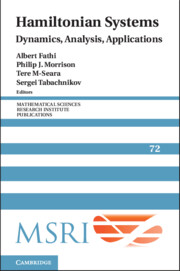Book contents
- Frontmatter
- Contents
- Denjoy subsystems and horseshoes
- Impact Hamiltonian systems and polygonal billiards
- Some remarks on the classical KAM theorem, following Pöschel
- Some recent developments in Arnold diffusion
- Viscosity solutions of the Hamilton–Jacobi equation on a noncompact manifold
- Holonomy and vortex structures in quantum hydrodynamics
- Surfaces of locally minimal flux
- A symplectic approach to Arnold diffusion problems
- Hamiltonian ODE, homogenization, and symplectic topology
A symplectic approach to Arnold diffusion problems
Published online by Cambridge University Press: 10 May 2024
- Frontmatter
- Contents
- Denjoy subsystems and horseshoes
- Impact Hamiltonian systems and polygonal billiards
- Some remarks on the classical KAM theorem, following Pöschel
- Some recent developments in Arnold diffusion
- Viscosity solutions of the Hamilton–Jacobi equation on a noncompact manifold
- Holonomy and vortex structures in quantum hydrodynamics
- Surfaces of locally minimal flux
- A symplectic approach to Arnold diffusion problems
- Hamiltonian ODE, homogenization, and symplectic topology
Summary
The purpose of this text is to present a symplectic approach to Arnold diffusion problems, that is, the existence of orbits of perturbed integrable systems along which the action variables experience a drift whose length is independent of the size of the perturbation. We chose to focus on the construction of orbits drifting along “chains of cylinders”, taking for granted the existence of the chains. We however give a rather complete description of these chains, together with some elements on their symplectic features and some main ideas
to prove their existence. We adopt the setting introduced by John Mather to prove the Arnold conjecture for perturbations of Tonelli Hamiltonians, which we see as the good one to set out the various (and numerous) problems of the construction, and give some ideas to show how the symplectic approach may enable one to enlarge its scope.
Information
- Type
- Chapter
- Information
- Hamiltonian SystemsDynamics, Analysis, Applications, pp. 229 - 296Publisher: Cambridge University PressPrint publication year: 2024
Accessibility standard: Unknown
Why this information is here
This section outlines the accessibility features of this content - including support for screen readers, full keyboard navigation and high-contrast display options. This may not be relevant for you.Accessibility Information
- 1
- Cited by
